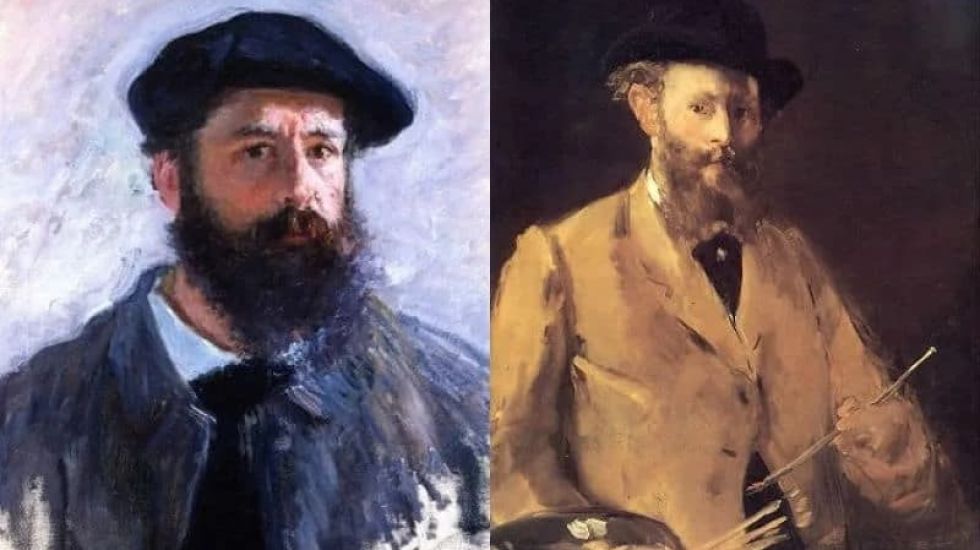Monet and Manet’s Backgrounds for A Better Understanding
Claude Monet was born in Paris in 1840; his parents moved him to Le Havre aged five.
Here, he became interested in painting and studied under landscape painter Eugene Boudin. Manet fell in love with nature while working on impressionist pieces.
However, Édouard Manet was born into a wealthy Parisian family in 1832 and had access to all kinds of luxury! Manet enrolled at Collège Rollin because his father wanted him to study law.
Why Did Manet Choose Art Over Law? It’s evident from reading about Monet and Manet that they had different art experiences. Edward decided to become an artist after enrolling in Thomas Couture’s École des Beaux-Arts. This school introduced him to genre settings, history paintings, and portraiture, which shaped his style.
Monet was drawn to Impressionism by his love of landscape painting, but Manet’s classical training allowed him to explore Romanticism and Realism later in life.
They each had different techniques, but they shared the goal of rejecting 19th-century European academic painting traditions. This shared aim helped them pioneer the contemporary aesthetic trend at the time, which made them famous among the greatest artists.
Impact of Claude Monet on Impressionism
Claude Monet is famous for creating, or at least naming, Impressionism art. His work concentrated on capturing natural light and capturing brief moments of nature’s beauty. Unlike Édouard Manet’s realistic realism, Monet’s outstanding use of color and illumination helped shape impressionism.
Have you marveled at a Monet painting? If so, you know how he captured Mother Nature’s stunning colors, forms, and textures with his work!
His delicate brushstrokes conveyed emotions in his landscape paintings. He improved this technique by utilizing varied tones for daytime images and darker hues at night to convey distinct messages. It’s spectacular how Claude could swing from light tones and dark shadows in one piece!
Claude Monet was a huge fan of this new painting style, and he often used reflections from running water in his paintings to make them more colorful than other Impressionist paintings. Have you noticed how nighttime hues change? Absolutely magical!
He sometimes painted his subjects many times to portray their changing appearances due to weather or lighting changes during the day or evening.
He tried different methods, including painting outside (on location), which captured natural surroundings while retaining an Impressionistic mood with free brushwork and brilliant colors. Monet tackled figures in indoor situations and nature-based compositions of flowers and fruits in addition to landscapes.

The Notable Way of Édouard Manet Painting
Édouard Manet and Claude Monet have great Impressionist portfolios, but Manet has something specific that sets him apart. He devoted particular attention to color depth and made areas more vibrant than Monet’s light effects. This unique artwork style made him memorable?
Manet’s realism is most shown in “The Luncheon on the Grass”. Two formally dressed middle-class picnickers are with an unclothed woman. He used bold lines and dark colors to build his paintings, unlike Monet. Manet’s attention to detail and realistic scenes suggest he was questioning society’s norms!
Manet’s approach to art was different from other Impressionists.
Empty spaces and blanks gave his paintings flexibility. The artwork “A Bar at the Folies-Bergere” showcases his unique style. We observe two males talking on one side of the bar with a bartender facing away from them into a vacant space with tables full of people mingling or having fun. The gaps and blank areas signify what? Does it represent emptiness despite customers? Do they represent something we can’t understand after staring at this painting for a moment?
The emptiness provides depth to this artwork, making viewers feel like they are in that bustling place taking in its climate as if their essence concerns are too!
This empty space gives this painting a lighthearted feel unlike anything other by an Impressionist painter, including Monet! Manet’s ability to convey so much with few details is almost unearthly. What kind of skill does an artist need to convey that much passion without words? It is stunning and makes us wonder what he was thinking when he produced this masterpiece.
He seemed to have reached a new level of expression, which shows why he was so unique among painters at the time.
Impressionists combined multiple subjects into one scene, but Manet’s compositions were more simple, usually consisting of one or two figures taking up most if not all of the frame but still conveying an entire experience!
French Artists Monet and Manet Influence on Art History
We usually think of Claude Monet and Édouard Manet as prominent French artists. Both painters painted on comparable subjects. One notable distinction between the two was how much detail or action they put in their pieces. Manet’s minimalist paintings conveyed strong emotion despite few characters or details, unlike Monet’s, who used several individuals to create a richer setting.
Manet distinguished himself from impressionists like Claude Monet by conveying emotion without overwhelming his audience. He made sure every brushstroke counted when painting, so people could understand it even if they didn’t look attentively.
They were both late 19th-century Impressionists who depicted daily life in various ways. They had some similarities but also many differences. Monet, whose inspiration came from nature, employed light and shadow to give his works profundity. Capturing beauty around us—what’s more inspiring?
Claude Monet was famed for painting outdoors with fast strokes that captured the occasion. He led and pioneered Impressionism by truthfully depicting people from all walks of life living their lives rather than focusing on light or shadows to create environment or depth. How did he capture these everyday scenes so well?
Manet captured everyday events that illuminated morality, justice, social structure, and gender norms in his period. Manet’s work is considered more traditional because he showed everyday situations rather than abstract thoughts like Monet’s landscapes or water gardens.
I think many painters pursue novel themes, but they can also convey meaning from simple images depicting reality around us, like how Manet used real-life settings to express morals or cultural standards!
Both French Impressionists have had a lasting mark on art history. Each has a unique approach when making masterpieces, which can be viewed in galleries worldwide! How much influence have they given us? What would modern art appreciation be like without them? The answers may surprise you…
Monet and Manet Style Differences
The techniques of Monet and Manet differ greatly, although they both painted what was happening around them. Both were late nineteenth-century French impressionists, but their methods differed.
Monet’s paintings were alive with vibrant colors and energetic strokes that caught light as it moved across a scene. This allowed him to depict mood fluctuations with time of day or season. He was a pioneer in portraying how outdoor lighting brought images to life, even on an oil canvas! He also had more control over composition because image frame elements were now reflections of reality beyond the window-like viewfinder.
He wanted his art to give viewers a ‘impression’ of nature rather than a convincing depiction. It was more about painting reality’s beauty than his visual perception of it!
Manet used stronger brushstrokes to create realism, unlike Monet, who used abstracted forms with blurred edges to create the illusion of motion. His painting has finer edges and more unique elements than Monet’s, as if it were really caught photographic pictures from the past! Their style and topic matter were unique! It may not have been obvious, but this helped them establish two distinct art identities during their period. How could these artists have employed such different styles? Maybe it was due to life and background differences, or maybe they sought different effects for each piece?
Whatever the case, we’ll never know.
Monet mostly painted real-life landscapes and outdoor scenes of nature’s grandeur. Manet specialized on people or figures, creating still lifes or portraits of ordinary situations. That is crucial because Monet painted what he saw without symbolism, while Manet used allegorical aspects to convey a larger message. Have you ever been caught in thought admiring a painter’s brushstrokes conveying emotion?
Despite their different methodologies, both artists loved presenting nature’s wonders with brilliant colors and inventive designs!
To conclude, Monet and Manet are Impressionist masters. The masterpieces of both French painters will be cherished forever. While they may seem similar, they have different approaches and styles.
Monet used light from nature to generate many concept ideas, while Manet used vibrant tones and riveting brush strokes to reshape modern art history. When placed side by side, you may enjoy each painter’s creative input to this style of artwork, which is sure to delight any visitor!

